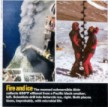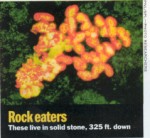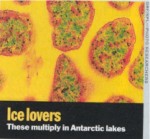HOW LIFE BEGAN
They thrive on boiling heat, freezing cold, radiation and toxic chemicals - and they have triggered a revolution in biology
By MICHAEL D. LEMONICK and ANDREA DORFMAN.
The frozen continent of Antarctica is almost equally deadly, but at the other end of the temperature scale.  Drill into the ice cap a mile, then another, and you reach, improbably, a body of water known as Lake Vostok that rivals Lake Ontario in size. While scientist haven't yet drilled into the lake itself, they have pulled up samples of frozen lake water clinging to the bottom of the ice cap that contain unmistakable evidence of microbial DNA. Although it hovers near the freezing point, cut off from light and outside nutrients, Lake Vostok is teeming with microorganisms. "Nobody," marvels John Priscu, a Montana State University microbiologist who has studies the samples, "thought there could be any life down there."
Drill into the ice cap a mile, then another, and you reach, improbably, a body of water known as Lake Vostok that rivals Lake Ontario in size. While scientist haven't yet drilled into the lake itself, they have pulled up samples of frozen lake water clinging to the bottom of the ice cap that contain unmistakable evidence of microbial DNA. Although it hovers near the freezing point, cut off from light and outside nutrients, Lake Vostok is teeming with microorganisms. "Nobody," marvels John Priscu, a Montana State University microbiologist who has studies the samples, "thought there could be any life down there."
Remarkable as these discoveries might once have seemed, they have become almost commonplace. In the past few months alone, researchers have extracted colonies of microbes that thrive at 137°F in an underground hot spring in Idaho and found others eating into volcanic rock 1,2000 ft beneath the sea floor. Over the past few years, in fact, scientists have been finding life in all sorts of places where biology textbooks say it shouldn't exist. Microorganisms are thriving in thermal springs in Yellowstone National Park and in pristine veins of water two miles underground in South Africa. They[re living in solid rock at the bottom of deep mines. They're growing in brine pools five times saltier than the ocean, in tiny pockets of liquid embedded in sea ice and in places with toxic levels of heavy metals, acids and even radiation.
Taken one at a time, these creatures - formally known as "extremophiles," or lovers of extreme environments - are fascinating curiosities. Collectively, they have: triggered a scientific revolution, forcing researchers to rethink biology's most basic assumptions about how life began.
Extremophiles also represent a biotech bonanza, pumping out unique substances; that could be invaluable in all sorts of industrial and medical applications (see box). Polymerase chain reaction (PCR), for example, the DNA-amplifying method used most famously in the O.J. Simpson murder trial, exploits an enzyme manufactured by a Yellowstone extremophile.
But the importance of these microbes goes much further. While some extremophiles are bacteria, some are so different from any other single-celled organism that scientists have created a new biological kingdom, called Archaea (from archaic), to accommodate them. As the name suggests, Archaea may be similar to the very first organisms that populated the earth billions of years ago. The implication: life on our planet may first have arisen, not in a warm tidal pool as Darwin and others theorized, but under conditions of sulfurous, searing heat.
 Finally, there's a cosmic dimension to these bugs. So-called exobiologists and astrobiologists,
who speculate about life beyond Earth, have long assumed that liquid water is a minimum requirement for existence. But if that water can range from frigid to boiling, and if burial underground isn't a problem,
then it's not crazy to think that life exists in the permafrost beneath the surface of Mars, or in the ice-capped ocean that may encircle Jupiter's moon Europa, or in the seas that - may exist on Saturn's moon Titan. Indeed, NASA considers extremophiles so relevant to its search for life in the universe that in 1997 it created the Astrobiology Institute at its Ames Research Center near San Francisco, devoted in part to the study of these peculiar organisms.
Finally, there's a cosmic dimension to these bugs. So-called exobiologists and astrobiologists,
who speculate about life beyond Earth, have long assumed that liquid water is a minimum requirement for existence. But if that water can range from frigid to boiling, and if burial underground isn't a problem,
then it's not crazy to think that life exists in the permafrost beneath the surface of Mars, or in the ice-capped ocean that may encircle Jupiter's moon Europa, or in the seas that - may exist on Saturn's moon Titan. Indeed, NASA considers extremophiles so relevant to its search for life in the universe that in 1997 it created the Astrobiology Institute at its Ames Research Center near San Francisco, devoted in part to the study of these peculiar organisms.
The idea that America's space agency would one day focus on extreme microbes would have seemed utterly far-fetched in the late 1960s, when researchers discovered a microbe known as Thermus aquaticus in near boiling springs in Yellowstone National Park. At the time, the bizarre creature seemed little more than a biological oddity.
But a decade later, deep-diving submersibles scanning the midocean ridge near the Galapagos Islands stumbled on something totally unexpected: plumes of toxic water spewing from cracks in the sea floor. Huddled around these awful oases were entire ecosystems made up of hundreds of hitherto unknown species, ranging from bright red tube worms to ghost-white crabs and anemones.
At the bottom of the food chain were microbes that, scientists soon realized, were thriving on nothing more than heat and poison. "They make a living," explains John Baross, of the University of Washington's School of Oceanography, "by oxidizing sulfide, methane, iron and other metals." After years of digging into the sediments in and around vents, Baross discovered that these microbes have adapted to a wide variety of thermal conditions, from room temperature to well above boiling.
While their hardiness was a big surprise, the microbes' ability to eat hydrogen, sulfur, manganese and other chemicals - a process known as chemoautotrophy - was a revelation.  Until then, all living systems were thought to depend on photosynthesis, using sunlight as a primary energy source. (Even cave-dwelling or deep-water creatures who never see the sun eat organic matter that ultimately originates from photosynthesis.) But if life could thrive without even indirect contact with sunlight, the amount of potentially habitable real estate on the planet would expand considerably.
Until then, all living systems were thought to depend on photosynthesis, using sunlight as a primary energy source. (Even cave-dwelling or deep-water creatures who never see the sun eat organic matter that ultimately originates from photosynthesis.) But if life could thrive without even indirect contact with sunlight, the amount of potentially habitable real estate on the planet would expand considerably.
And indeed, life began to turn up just about everywhere scientists looked. Geologists had been arguing since the 1920s, in fact, that chemical contaminants found in crude oil suggested that some sort of life was thriving underground. They weren't taken seriously until the 1980s, though, when Department of Energy scientists realized that if subsurface microbes really did exist, they might playa key role in regulating the purity of groundwater. So they began digging boreholes at DOE sites in South Carolina and Washington State.
Sure enough, they found bugs living more than 1,500 ft. down-cut off, like their ocean-vent cousins, from any conceivable contact with the surface. No one knows how deep the biosphere extends, but Tullis Onstott, a geologist at Princeton, has followed the trail two miles straight down: he began exploring South African gold mines in 1998, and so far he and his international colleagues have pulled out scores of heat-tolerant, hydrogen-eating bugs from subsurface water.
Many of them are bacteria, but some, just as biologists discovered at ocean vents and hot springs, turn out to be something else entirely. By looking carefully at their genes, Carl Woese, of the University of Illinois, realized that while they shared bacteria's key feature-the absence of a distinct nucleus-their genes more closely resembled those of more advanced cells. He proposed, and his colleagues accepted, that these odd organisms should be given their own kingdom. Before, bacteria were classified as Prokaryota, while everything else, including fungi, plants and people, were considered Eukaryota. To these, Woese added Archaea. "Archaea," says University of Colorado biologist Norman Pace of Woese's new classification, "has shaken up how we think of the origin of life."
 Basically, Pace and others believe that Archaea may be the closest thing we have to the original life forms that populated the earth. The case is circumstantial, but compelling. For one thing, their genetic makeup suggests they've evolved less than the other two kingdoms from the common ancestor of all earthly life. For another, most of (though not all) the Archaea are heat-loving extremophiles - and, as Baross
points out, "the early earth was riddled with ridge systems and submarine volcanic eruptions." The young earth was also awash in the same harsh chemicals and metals that extremophiles thrive on today.
Basically, Pace and others believe that Archaea may be the closest thing we have to the original life forms that populated the earth. The case is circumstantial, but compelling. For one thing, their genetic makeup suggests they've evolved less than the other two kingdoms from the common ancestor of all earthly life. For another, most of (though not all) the Archaea are heat-loving extremophiles - and, as Baross
points out, "the early earth was riddled with ridge systems and submarine volcanic eruptions." The young earth was also awash in the same harsh chemicals and metals that extremophiles thrive on today.
Most extremophile communities are dominated by bacteria, not Archaea. But after seven years of looking, Francis Chapelle, of the U.S. Geological Survey in Columbia, S.C., found an exception. Lidy Hot Springs, in Idaho's Beaverhead Mountains, is some 600 ft. underground. Its temperature hovers at 137°F, and more than 90% of its microbes are Archaea that consume hydrogen gas and belch out methane. That ratio, wrote Chapelle in Nature, makes this community "unlike any previously described on earth." If Pace and others are right about Archaea's pedigree, says Chapelle, then "systems like Lidy Hot Springs become very important to understanding what life may have looked like on the early earth."
If the heat lovers represent the original inhabitants of earth, cold-loving extremophiles could show us what kinds of creatures might live beyond .the earth, in parts of the solar system previously thought uninhabitable. Says microbial ecologist Jody Deming, of the University of Washington: "The surfaces and planets we have to consider are frozen, so we needed to know more about frozen environments."
Deming's specialty is sea ice, which may look solid, but is actually riddled with tiny channels and pores filled with very salty water. Microbes that live in sea ice have to survive temperatures that vary from just below freezing to -310 F. And although Deming is just beginning to understand how they do it, she has learned that at least one genus is closely related to bacteria that live in the deep ocean - suggesting that the adaptations to cold and to high pressure are somehow linked.
This is good news for scientists who hope to find life on Europa, a moon of Jupiter's that is covered with ice but probably has an ocean beneath.  According to Deming, indirect analyses of Europa's surface suggest that it contains salts, and that they are the same salts found in Earth's oceans; any microbes that exist on Europa might resemble the ones she has found.
According to Deming, indirect analyses of Europa's surface suggest that it contains salts, and that they are the same salts found in Earth's oceans; any microbes that exist on Europa might resemble the ones she has found.
They might be even more similar to the bugs Montana State's Priscu is sure lurk in Lake Vostok, not just in its near freezing waters but in the hundreds of feet of sediment he believes lie at the bottom. Russian drillers and their international collaborators aren't going to penetrate the lake itself until they have designed a system that won't taint the pristine water with contaminants from higher up. But when they do-probably within the next few years-they will be able to see what's going on in a nearly perfect analogue of Europa's oceans. And the techniques they develop will be applicable to eventual searches for life on that distant moon. "It's humbling," Priscu says, "to find microbes where you never imagined they could exist."
It's also clear that there are plenty of surprises left. Says Priscu: "In the '70s, when I first got interested in this field, many colleagues called claims of life in extreme environments 'hand waving.'" Since then, he and the other extremologists have found life inside glaciers, at the bottom of mines, in searing heat, freezing cold, crushing pressure and lethal toxicity. And that's after exploring only a tiny fraction of the planet What they have discovered so far has transformed biology. What they will find next is anybody's guess.